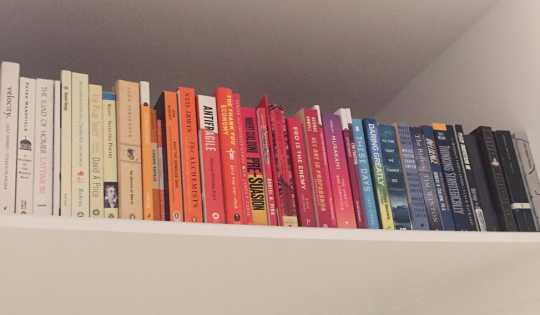170553838527

Quite a striking email from the Hinge Team.
The purpose of this email is a feature announcement. The tell? “You’ve probably noticed some changes.”
Often product teams leave this sort of thing to last minute tweets, or worse, wait until their users start to email in yelling about how everything looks different, and asking for refunds. Oh that’s just my team? mops brow and loosens tie
Anyway, the point is, this is the not where effort usually goes. We’re busy putting out fires, and writing code, not drafting up lovely product announcement emails!
Usually a task like this is handled by a busy product manager who has better things to do. Seemingly not the case at Hinge. Here’s a few things that I like about it.
• The type. This email has beautiful big type. Designers might notice the serif (the pointy feet on the letters) that has long been chased off into the hills by Silicon Valley haters. Serifs are rarely seen in marketing documents, let alone UI. That’s another point. Since they prominently uses a serif typeface in their app, brand is leaking freely between product and marketing like it should.
• The color. has been applied in a smart and strategic way. I’m not familiar with Hinge’s branding outside of the app, but consider how the powder blue has been applied. At the top it’s an accent for the illustration, in the body it’s used to lead your eyes through the UI screenshots and at the end, it fills the nice big CTA button. Obvious, but sparing. The fact that it plays nicely with the cream background is a nice bonus, and you won’t see them together on mobile anyway.
• The copy. Copywriting is a personal interest of mine, and I love to see it applied with a bit of thought. All of the titles are benefits, eg. “Don’t lose track”. Losing track of conversation threads is a pain for users, and Hinge is showing us that with this new feature, it’s no longer a problem. A side note, drafting up a document like this email before you build something is a great way to frame your feature around your customer. Also, signing of with ‘love’ is a nice touch.
• CTA deep links to the app. Technology!
I think this is a good benchmark for informational-producty emails to your userbase. Clearly explain your changes, the benefits, how it works and don’t miss the opportunity to hammer in your brand while you’re at it.
Love,
Josh
Hacking through a jungle
There are only a two times when I feel at ‘one’ with New York.
And they are quite different.
One is swimming up a waterfall, the other is diving off the top just to see what happens.
The first is a typified by rushing across town for something. Or arguing your way into a club, yelling at bad drivers, pushing past tourists. That sort of thing. You are willing yourself to power. You will get to what you want, even if it kills you. It’s not ‘exploring’, it’s hacking your way through a jungle.
The second is typified by being pleasantly drunk, carried down a busy street like a leaf in a stream. You couldn’t care what New York has to say for itself, you’re just here to exploit it. Planning, plotting, bending rules and general subversion of the way things ‘should be’. Another analogy would be coasting down a quiet street on a citibike. You’re finally in control for once, and you can relax and enjoy the view.
Why is it this way? The smaller and more timid you are, the heavier the city feels. Sometimes you might drown.
The bigger you are, the more confident and gregarious, the more you command the city. It bends for you.
At both extremes, you lose touch with yourself, and sink into the city. In devil may care hedonism or violent chaos - you connect and become one.
Or at least, it stops fucking with you.
Every Book I Read in 2017

Goal: 50. Read: 50. Total pages: 10,745. Average Rating: 3.67
And here are the books, in reverse-chronological order. I’ve bolded my favorites.
50. The Life to Come - Michelle de Kretser
Ways of Seeing - John Berger
About Face - Alan Cooper
Plato and a Platypus Walk into a Bar - Thomas Cathcart
Decode and Conquer - Lewis C. Lin
The Elements of User Experience - Jesse James Garrett
44. Esquire Etiquette - Glen Waggoner
- What makes an effective executive - Peter Drucker
42. The Dictators Handbook - Bruce Bueno de Mesquita
Jesus - Paul Johnson
Antifragile - Nassim N Taleb
These Days - Jack Cheng
The New CSS Layout - Rachel Andrew
Win Bigly - Scott Adams
Super Forecasting - Philip E. Tetlock
The Hitchhikers Guide to the Galaxy - Douglas Adams
Developer Hegemony - Erik Dietrich
The Goal - Eliyahu M. Goldratt
How Adam Smith Can Change Your Life - Russ Roberts
31. Finite & Infinite Games - James P Carse
The Complacent Class - Tyler Cowen
Damn Good Advice - George Lois
The Inevitable - Kevin Kelly
27. China in 10 Words - Yu Huijiao
- The Phoenix Project - Gene Kim, George Spafford, and Kevin Behr
25. The Lords of strategy - Walter Kiechel
- Git for Humans - David Demaree
23. 1984 - George Orwell
- Ego is the Enemy - Ryan Holiday
21. The Handmaid’s Tale - Margaret Atwood
The Elements of Eloquence - Mark Forsyth
On Tyranny - Timothy D. Snyder
A Short History of Nearly Everything - Bill Bryson
Sass for Web Designers - Dan Cederholm
Australian History in 7 Questions - John Hirst
The Couple Next Door - Shari Lapena
14. Nutshell - Ian McEwen
13. How to Get Filthy Rich in Rising Asia - Mohsin Hamid
Girt - David Hunt
The Great Cholesterol Myth - Jonny Bowden and Stephen Sinatra
Moveable Feast - Ernest Hemmingway
9. The Man Who Mistook His Wife For A Hat - Oliver Sacks
A Technique for Producing Ideas - James Webb Young
Casino Royale - Ian Fleming
Down Under - Bill Bryson
5. The True Believer - Eric Hoffer
Liar’s Poker - Michael Lewis
On Bullshit - Harry Frankfurt
Sweet Poison - David Gillespie
1. Everywhere I look - Helen Garner
2017

The last time I formally reviewed my year, was in 2015.
Damn, I was so happy then! What happened? A lot has happened since 2015. Alot has happened since November, but I like the practice of looking back (and looking forward), so here we go again.
Space
2017 started 10,000 miles away, in Melbourne, Australia.
My time back home went too fast. Luckily, my company was ok for me to work remotely for a few months, which was truly generous and really changed the course of the year for me. As an expat, every waking hour is tinged with the weirdness of a foreign experience that never truly becomes normal, and rebounding home after a long stint away can be best explained as wiping away the weird. Sunlight is the best disinfectant, and there’s no sunlight like Aussie sunlight.
Most big trips I did this year were centered around family. After a few months in freezing New York, I was in Napa, for the annual Tour de Cure charity ride. Later, in the middle of Summer, I spent more time on the west coast, driving with my Dad from Portland to Carmel for two family weddings. It wasn’t all positive. In October, I rushed to Fort Lauderdale, to catch my Grandpa who had been admitted into hospital. I finished the year, back in Petaluma, for thanksgiving, which has started to become a permanent fixture on my calendar and a sort-of spiritual bookend of my year.
Time
The one thing that I spent the most time fixated with in 2017 was a small piece of plastic that I was waiting for the government to give me. I’d embarked on the green card process quite naively, thinking I’d hit a home run. With a green card, I could do anything I wanted in America, move, start a business, switch jobs, yet it came with a small catch. It took time. Time filling out forms. Time waiting in lines. But mostly just waiting. That was what nearly broke me. Was I making a bad decision? What was the opportunity cost? I felt like I was starting to lose it. The green card locked me in the States, locked me in my job, and the longer it took the deeper my cost sunk.
Several people helped me move past this psychological slump — My family, friends, random people on twitter, but my girlfriend C especially, who bore the brunt of my complaints. She helped me see the positive side, but importantly she pushed me into action, and I spent the better half of 2017 fueled by this furious energy to do. If I was ’stuck’ (how I framed it, anyway), I’ll make the fucking most of it. I learnt to code. I networked. I met and picked the brains of some of the smartest people I’ve ever met in New York. I got in the best shape of my life. I wrote. I read more than I’ve ever read. I couldn’t leave the country, so I travelled all over the U.S (Montana, Wyoming, Louisiana, Colorado). I moved into my own place. And for the first time, again thanks to C, I really lived New York — its music, its people, its art and food. Maybe the obstacle can be the way.
Place
“You have to exert yourself at America or it will exert itself at you.“ - Mark Pollard
I’ll wrap this up with what I think was my most important ‘moment’ of this year. But it’s hard to explain. Since I moved to the States, I’ve been incredibly determined on reaching small goals, (actually my 2015 post is full of them), to prove something to myself. That was great, but I’d never taken a step back to look at the bigger picture. Why was I here? What did I really want? And for the first time I felt like I was living in an alien country — and the true distance (in every sense of the word) from home.
The bubble burst. I guess you can only keep it inflated for so long. Unplugging the belief that “I need to live here”, or “I need to do X”, allowed many plans and decisions to quickly resolve themselves. It felt incredibly good ‘not to care’, for once, and that’s something I’ll be thinking about when 2018 inevitably rolls around.
A Toy Universe in Our Heads
In which three random guys, talking about three semi-related things, show us how to design better software.
First, Venkatesh Rao, speaking to Shane Parrish on the Knowledge Project.
• Mental models are less about how the world works and more about internal consistency.
• Why? The universe is an extraordinarily confusing place. The information we receive through our retinas alone would make our heads explode.
• We’ve evolved to process this fire hose of information in a way that allows us to map it to a ‘toy universe’ inside our heads.
• When we shut our eyes and make a decision, for example, what school to apply for college, we are playing with this ‘toy universe’.
• For our mental models to work it has to be two things. 1. Simple. 2. Internally consistent.
That’s the function of mental models: simplicity and coherence.
Sound about right? Now let’s switch gears into software development.
Next up, Alan Cooper, from this seminal 1995 book About Face.
“Software interfaces are often designed by engineers who know exactly how the software works.”
• I’d add to this and say even great software developers have a limited understanding of how the software works, they may know specifics, but rarely the whole stack.
“…the result is software with a manifest model very consistent with its implementation model. This is logical and truthful, but not very effective. The user doesn’t care all that much about how a program is actually implemented.”
• This is generous — Even developers don’t care how a program is implemented. They may rely on their working knowledge (for example, understanding why the program is throwing an error), but they usually just want to buy tickets to Tahiti, or reserve a seat for the new Star Wars film.
• “…the complexity of implementation can make it nearly impossible for the user to see the connections between his actions and the programs’s reaction…Even if the connections were visible, they would remain inscrutable.
So, we can see that software that doesn’t consider the mental models of the user, is doomed to fail.
Finally, enter Daniel Jackson, MIT Professor.
• Software construction needs design, not science.
• In the context of constructing a building, designers and engineers have a few key differences. Designers are concerned with visible elements, like doors, windows and walls. Engineers, in contrast, columns, beams and trusses.
• In software, it’s a similar division.
• Designers and engineers are largely concerned with system and the users of the system. But like in construction, their goals diverge.
• If the goals of an engineer is to ensure a stable, performant, correct, maintainable system, the goals of the designer are largely making the system enjoyable, learnable and effective for the user.
• If the ‘elements’ used by the developer to achieve their goals are functions and objects, what does the designer use?
• Daniel Jackson thinks it’s mainly “concepts” that explain how software works.
• For example, Twitter can be explained by the concepts of ‘tweets’, ‘hashtags’ and ‘following someone’.
• These small concepts help explain the system, and help the user ‘use’ it, or work within it.
• Twitter would be pretty hard to understand if you didn’t get the concept of ‘following’.
• Concepts can be evaluated by their purpose.
• The purpose of the ‘trash’ concept, in the Mac Finder is to “allow undo of deletions.”
• If you delete a file, it moves to a special folder (trash). You can restore it from there, but emptying it removes contents for good (and makes space on the disk).
In a well-designed system, each concept is motivated by one purpose.
And purposes, are really just the structured needs of users.
Don’t recreate the universe. Leverage mental models and concepts to build working, well designed software.
